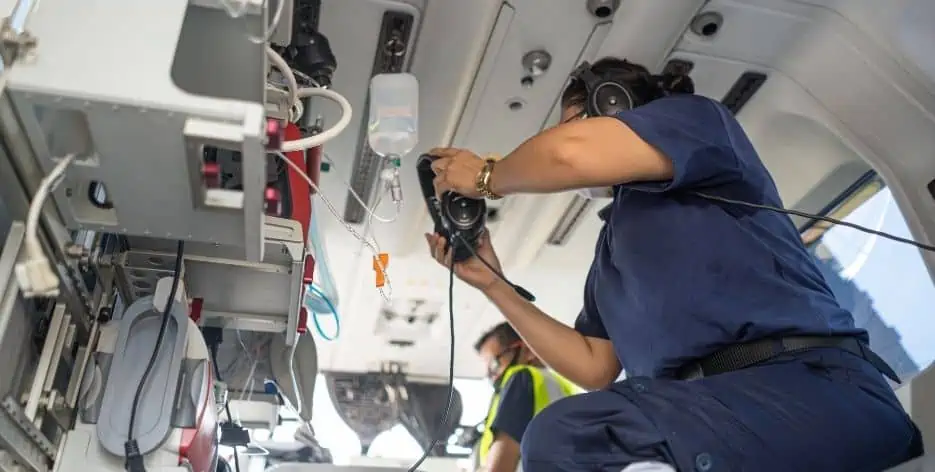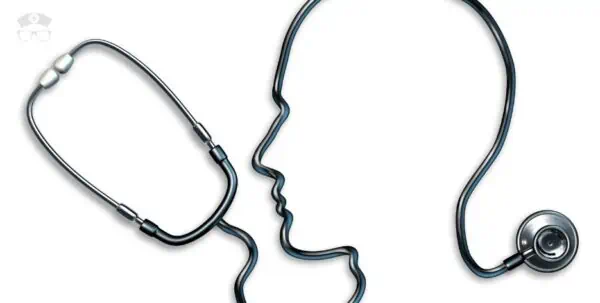Medical emergencies can happen anywhere and at any time. That’s why there are specially trained medical professionals who are able to provide care in a variety of settings, including in the air. Flight medics and flight nurses are two such professionals. So, what’s the difference between a flight medic vs flight nurse? Let’s take a look.
In most emergencies like road accidents, heart attacks, drownings, etc., the response is made by ambulance. But what if someone has a medical emergency in a remote location or in an area that is difficult to access by road? That’s where flight medics and flight nurses come in. They are specially trained to provide medical care in these types of situations.
What are Flight Medics?
Flight medics (also called Flight Paramedics, Air Medics) are trained to provide medical care in various settings, including in the air. They are able to assess and treat patients with a variety of medical conditions. In addition to their medical training, flight medics also receive training in aviation and safety. This enables them to provide care safely and effectively.
What Does a Flight Medic Do?
Like all health professionals, the primary job of a flight medic is to provide care to patients. This includes assessing and treating patients with a variety of medical conditions. Flight medics may also be involved in transporting patients to and from hospitals using helicopters.
Since flight paramedics are flying at low altitudes, they face higher risks than ambulance crews in emergencies. As a result, they receive training in in-flight safety and protocol.
Common Responsibilities for Flight Paramedics Include:
- Emergency medical flights to and from hospitals (patient transport)
- Treating wounds and injuries in emergency situations
- Giving medication, injections, and IVs
- Assessing and stabilizing patients
- Keeping track of medical supplies
- Checking first aid equipment
- Making sure employees can return to work
- Taking patients for additional medical care
- communicating with remote medical control and doctors while treating patients
- They perform advanced medical procedures such as intubation, ventilator management, line placement, general anesthesia, and paralysis.
So these are some of the responsibilities that a flight medic has.
Average Flight Paramedic Salary
According to Payscale, the average hourly pay for a Flight Paramedic is $23.15.
- An early career Flight Paramedic with 1-4 years of experience earns an average total compensation (includes tips, bonus, and overtime pay) of $22.97 based on 33 salaries.
- A mid-career Flight Paramedic with 5-9 years of experience earns an average total compensation of $22.58 based on 34 salaries.
- An experienced Flight Paramedic with 10-19 years of experience earns an average total compensation of $23.65 based on 56 salaries.
- In their late-career (20 years and higher), employees earn an average total compensation of $26.
Flight Paramedic Requirements
Let’s see how to become a flight medic?
The requirements for flight medic vary from company to company, but there are some standard requirements that most flight medic jobs have.
Educational Requirements
- Be Licensed as a paramedic by a state EMS board
- 3 to 4 years of critical care experience as a paramedic
- BLS, ACLS, and PALS certification
- CCP-C or FP-C credential (Optional but preferred by some employers)
- Completion of an accredited flight training program
- You must complete the NREMT paramedic cognitive and psychomotor certification exams
- Some companies may require you to have a bachelor’s degree in addition to the above requirements.
Additional Requirements
- Candidates must have a high school diploma or equivalent.
- Candidates must have completed EMT, Paramedic, or another medical training program.
- Candidates must have a valid driver’s license.
Flight Paramedic Required Skills
Besides educational and certification requirements, flight medics must have the following skills:
- Ability to work under pressure: Flight medics must be able to work well under pressure and in a fast-paced environment. They may have to deal with patients who are in critical condition.
- Excellent communication skills: Flight medics must be able to communicate effectively with patients, families, and other members of the healthcare team.
- Good physical stamina: Flight medics must be physically fit as they will have to lift and move patients.
- Good problem-solving skills: Flight medics must be able to identify and solve problems quickly.
What are Flight Nurses?
Flight nurses (also called Air Nurses) are registered nurses who have received special training in aviation and safety. They can provide medical care in a variety of settings, including in the air. They must be able to assess and treat patients with a variety of medical conditions. In addition to their medical training, flight nurses also receive training in aviation and safety. This enables them to provide care safely and effectively.
What Does a Flight Nurse Do?
A flight nurse, also known as a transport nurse, is an RN who is specially trained to provide medical care to patients during aircraft transportation. The primary job of flight nurses is to keep patients stable until they reach the hospital. They work in both civilian and military environments. And they may be involved in transportation by ground, air, or sea.
Flight Nurse Responsibilities:
- Provide basic life support to patients
- Manage patient records and paperwork
- First aid, IV insertion, resuscitation, and more on the way to the destination
- Maintain aircraft supplies and equipment
- Assist the pilot with radio communications or other duties
- Assist in getting patients into and out of the aircraft safely
- Make sure the patient is securely seated on board
- Check vital signs
- Maintain effective communication with team members and patients
- Sometimes dealing with death situations
As you can see, the duties of flight nurses and medics are almost similar except for a few responsibilities.
Average Salary of Flight Nurse
According to Payscale, the average hourly pay for a Flight Nurse is $33.28.
- An entry-level Flight Nurse with less than 1 year of experience can expect to earn an average total compensation (includes tips, bonus, and overtime pay) of $27.76 based on 5 salaries.
- An early career Flight Nurse with 1-4 years of experience earns an average total compensation of $32.06 based on 32 salaries.
- A mid-career Flight Nurse with 5-9 years of experience earns an average total compensation of $33.19 based on 47 salaries.
- An experienced Flight Nurse with 10-19 years of experience earns an average total compensation of $37.62 based on 27 salaries.
- In their late-career (20 years and higher), professional flight nurses earn an average total compensation of $38.
Flight Nurse Requirements
Every RN cannot become a flight nurse; there are some basic requirements that every flight nurse should have:
- Should have a current, valid RN license in the state of practice
- Bachelor’s degree in nursing from an accredited institution
- A minimum of 3 years full-time equivalent of critical care nursing experience is required prior to beginning training
- Completion of an accredited aviation medical training program
- Fitness is a must as they need to be able to lift and move patients
- Excellent communication skills
- Good problem-solving skills
Flight Nurse Certification and Education Programs
Several different organizations offer certification for flight nurses. The International Association of Flight and Critical Care Nurses (IAFCCN) offers the Certified Flight Registered Nurse (CFRN) credential. To be eligible for this credential, candidates must have a current RN license, at least 1 year of full-time experience as a critical care nurse, and must pass a written exam.
The Board of Certification for Emergency Nursing (BCEN) offers the Certified Flight Nurse (CFN) credential. To be eligible for this credential, candidates must have a current RN license, at least 2 years of full-time experience as a critical care nurse, and must pass a written exam.
What’s the Difference Between Flight Medic and Flight Nurse?
As we have seen, the responsibilities of a flight medic and a flight nurse are pretty similar, and their main goal is to provide care to patients in need of air transport. As for the salaries, flight nurses have more money per hour.
The main difference between the two is that flight medics are trained medical personnel who are responsible for the medical care of patients. In contrast, flight nurses are registered nurses who have additional training in aviation medicine. Flight nurses also have more experience working in critical care settings than flight medics.
FAQs
What Are Some of the Safety Risks?
When it comes to safety, there are always risks associated with the job. Some of the more common risks include:
- Exposure to infectious diseases
- Injuries from lifting and moving patients
- Falls
- Exposure to hazardous materials
Is It Safe?
As with any job, there are risks, both the flight medic and flight nurse jobs are as safe as any other medic and nursing job.
What Are the Hours Like?
Flight medics and flight nurses typically work 12-hour shifts. They may be on call for 24 hours at a time and may have to work overtime on occasion.
Can an LPN Be a Flight Nurse?
An LPN cannot work as flight nurses, they need to become an RN and then complete an accredited aviation medicine training program.
Begin Your Career
So now you have everything you need to know; it’s your choice to make. If you want to make a difference in people’s lives and be a part of something extraordinary, then a flight medic or flight nurse career may be the perfect fit for you.





